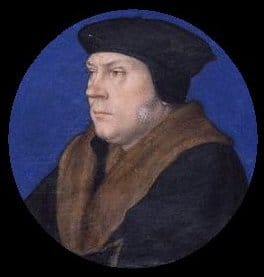 While Henry VIII was busy marrying wife number 5, his former chief minister Thomas Cromwell, Earl of Essex, was being beheaded on Tower Hill. Cromwell had been arrested on 10th June 1540 at a council meeting, and a bill of attainder was passed against him on 29th June 1540 for the crimes of corruption, heresy and treason.
While Henry VIII was busy marrying wife number 5, his former chief minister Thomas Cromwell, Earl of Essex, was being beheaded on Tower Hill. Cromwell had been arrested on 10th June 1540 at a council meeting, and a bill of attainder was passed against him on 29th June 1540 for the crimes of corruption, heresy and treason.
Cromwell climbed the scaffold on Tower Hill and addressed the gathered crowd:
“I am come hether to dye, and not to purge my self, as maie happen, some thynke that I will, for if I should do so, I wer a very wretche and miser: I am by the Lawe comdempned to die, and thanke my lorde God that hath appoynted me this deathe, for myne offence: For sithence the tyme that I have had yeres of discrecion, I have lived a synner, and offended my Lorde God, for the whiche I aske hym hartely forgevenes. And it is not unknowne to many of you, that I have been a great traveler in this worlde, and beyng but of a base degree, was called to high estate, and sithes the tyme I came thereunto, I have offended my prince, for the whiche I aske hym hartely forgevenes, and beseche you all to praie to God with me, that he will forgeve me.
O father forgeve me. O sonne forgeve me, O holy Ghost forgeve me: O thre persons in one God forgeve me. And now I praie you that be here, to beare me record, I die in the Catholicke faithe, not doubtyng in any article of my faith, no nor doubtyng in any Sacrament of the Churche. Many hath sclaundered me, and reported that I have been a bearer, of suche as hath mainteigned evill opinions, whiche is untrue, but I confesse that like as God by his holy spirite, doth instruct us in the truthe, so the devill is redy to seduce us, and I have been seduced: but beare me witnes that I dye in the Catholicke faithe of the holy Churche. And I hartely desire you to praie for the Kynges grace, that he maie long live with you, maie long reigne over you. And once again I desire you to pray for me, that so long as life remaigneth in this fleshe, I waver nothyng in my faithe.”1
Cromwell then knelt at the block and was beheaded “by a ragged and Boocherly miser, whiche very ungoodly perfourmed the office”2 – a botched execution in other words.
Walter, Lord Hungerford of Heytesbury, a client of Cromwell’s, was also executed on that day. He has gone down in history as the only man to be executed for the crime of “treason of buggery”3 in the Tudor period, but the charges against him also included:
- Treason for pretending to arrest Pilgrimage of Grace supporter William Bird, Vicar of Bradford-on-Avon, when he actually supported him by employing him as chaplain.
- Using magic, along with Sir Hugh Wood and Dr Maudlin, to predict how long Henry VIII would live.
As for the “buggery” charge, Hungerford had allegedly “exercised and frequented, and used the abominable and detestable vice and sin of buggery with William Master, Thomas Smith” and others in his household.”4
Hungerford was also beheaded on Tower Hill, following Cromwell on to the scaffold, and his head joined Cromwell’s on London Bridge. Retha Warnicke believes that it was the information that the King’s council gleaned about Hungerford, and his association with sorcerers and witches, that caused the heresy charges to be added to Cromwell’s bill of attainder because there was a “connection between sodomites and heretics.”5 Cromwell’s connection with Hungerford was definitely a way to blacken his name.
Henry VIII did come to regret Thomas Cromwell’s fall and execution. Marillac, the French ambassador, reported that the King had said that the King reproached his council for using “false accusations” to bring down Cromwell, complaining that “they made him put to death the most faithful servant he ever had.”6
Further reading on Thomas Cromwell:
- Henry VIII’s Enforcer: The Rise and Fall of Thomas Cromwell – A Review and Rundown
- Who was Walter Cromwell?
- 12th June 1540 – Thomas Cromwell’s Letter to Henry VIII
- The Real Wolf Hall – The Cromwell Family in Wolf Hall: The Family Man
Notes and Sources
- Kippis, Andrew (1789) Biographia Britannica: Or, The Lives Of The Most Eminent Persons Who Have Flourished in Great Britain and Ireland, Volume 4, p472
- Hall, Edward. Hall’s Chronicle, p839
- Chronicler Charles Wriothesley quoted in Warnicke, Retha (2000) The Marrying of Anne of Cleves: Royal Protocol in Tudor England, p228
- Warnicke, p227
- Ibid., p228
- LP xvi. 590